学习完C++类和对象,我们可以实现一个说简单也不简单的日期计算功能,该功能涉及大量的运算符重载知识点及细节,可谓是细节重重,那么本篇将手把手教会你自己写一个日期计算器?
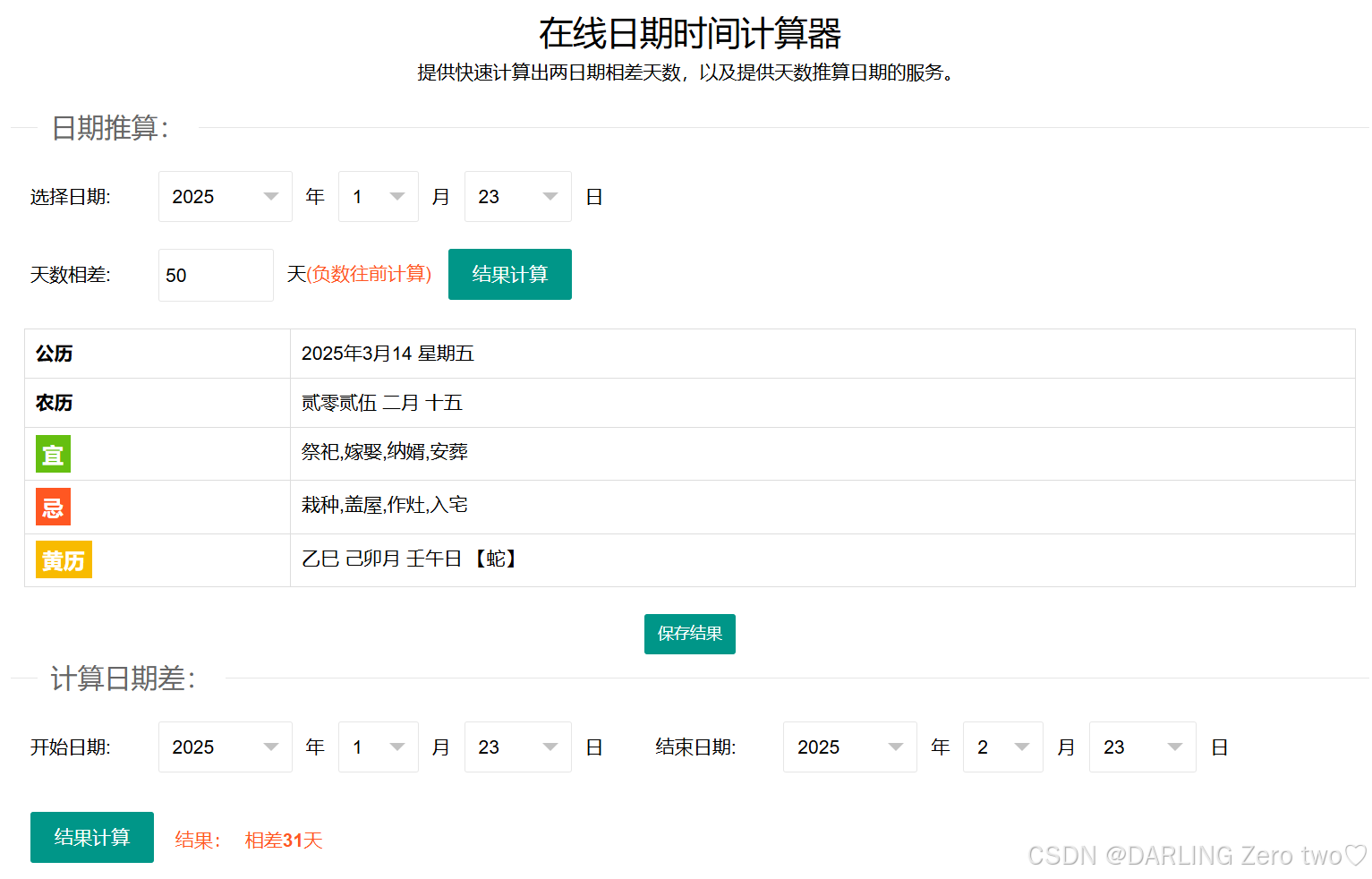
传送门:日期计算器(网页版)
1.基本构造实现
1.1 获取某年某月的天数
int GetMonthDay(int year, int month)
{
static int days[13] = { 0, 31, 28, 31, 30, 31, 30, 31, 31, 30, 31, 30,31 };
int day = days[month];
if (month == 2 && ((year % 4 == 0 && year % 100 != 0) || (year % 400 == 0)))
{
day += 1;
}
return day;
}
- 1
- 2
- 3
- 4
- 5
- 6
- 7
- 8
- 9
- 10
口诀:(四年一润,百年不润) 或者 四百年一润
1.2 构造函数
Date(int year = 1900, int month = 1, int day = 1)
:_year(year)
,_month(month)
,_day(day)
{}
- 1
- 2
- 3
- 4
- 5
用于初始化创建的每一个实例
1.3 拷贝构造函数
Date(const Date& d)
{
_year = d._year;
_month = d._month;
_day = d._day;
}
- 1
- 2
- 3
- 4
- 5
- 6
通常拷贝构造函数用于用一个已经存在的对象初始化另一个对象,如Date d3(d1),等价于Date d3 = d1
但是像d1 = d2是两个已经存在的对象之间的复制,调用的是=的运算符重载,而不是拷贝构造
具体实现解析可以看往期博客:
1.4 打印函数
void Print()
{
cout << _year << '-' << _month << '-' << _day << endl;
}
- 1
- 2
- 3
- 4
用于打印日期类
2.运算符重载接口实现
2.1日期比较
2.1.1 <运算符重载
bool Date::operator < (const Date& x)
{
if (_year < x._year)
{
return true;
}
else if (_year == x._year && _month < x._month)
{
return true;
}
else if (_year == x._year && _month == x._month && _year < x._year)
{
return true;
}
return false;
}
- 1
- 2
- 3
- 4
- 5
- 6
- 7
- 8
- 9
- 10
- 11
- 12
- 13
- 14
- 15
- 16
- 17
实现日期小于的比较,我们要先思考日期的比较需要分别比较年月日,从年开始依次比较,一旦成立则说明小于成立;反之应该是大于,小于不成立
?值得注意的是:
- 传参时要特别注意,
运算符有几个操作数,就传几个参数,this指针也算在参数中,
所以这里默认<左边的对象是用this指针传过去了,右边的对象引用传参(加const避免被传的数值被修改,引用传参提高效率) - 这里的运算符重载函数是
成员函数
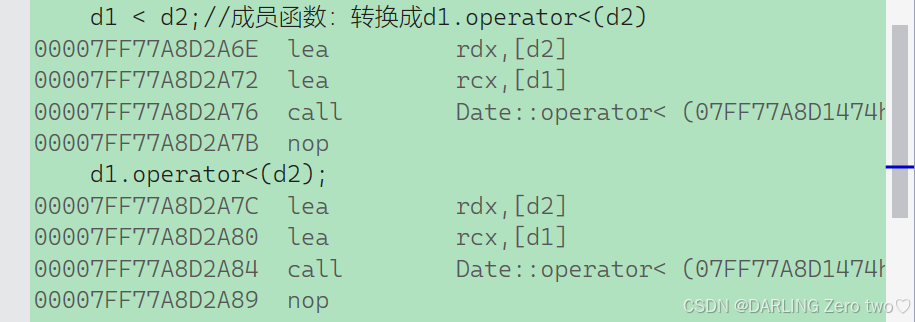
调试状态下,转到反汇编比较可以观察到,两种写法的底层代码是一样的,说明了d1 < d2会转换成d1.operator<(d2)
如果是非成员函数的情况下呢?
bool Date::operator < (const Date& x1, const Date& x2)
{
if (x1._year < x2._year)
{
return true;
}
else if (x1._year == x2._year && x1._month < x2._month)
{
return true;
}
else if (x1._year == x2._year && x1._month == x2._month && x1._year < x2._year)
{
return true;
}
return false;
}
- 1
- 2
- 3
- 4
- 5
- 6
- 7
- 8
- 9
- 10
- 11
- 12
- 13
- 14
- 15
- 16
- 17
注意在类内要添加友元的声明,在类外定义运算符重载函数时,要传两个参数,原因在于非成员函数没有隐含的 this 指针来指向调用对象。不像成员函数,通过 this 指针隐式获取左侧对象,只需要显式接收右侧对象作为参数
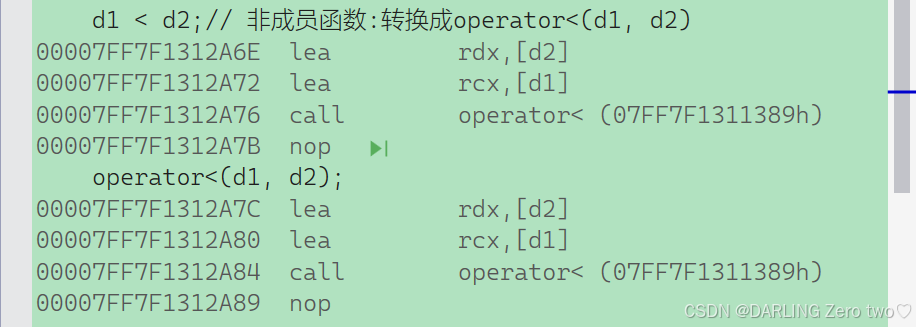
同样转到反汇编比较,可以观察到非成员函数下,d1 < d2会转换成operator<(d1, d2),底层代码也清晰的指出要传几个参数
2.1.2 ==运算符重载
bool Date::operator==(const Date& x)
{
return _year == x._year
&& _month == x._month
&& _day == x._day;
}
- 1
- 2
- 3
- 4
- 5
- 6
==的运算符重载很简单,直接返回即可,如果相等返回true;反之则为false
2.1.3 <=运算符重载
bool Date::operator<=(const Date& x)
{
return *this < x || *this == x;
}
- 1
- 2
- 3
- 4
显而易见,注意左边的数是由this指针隐式传递,满足小于或等于都能成立
2.1.4 >运算符重载
bool Date::operator > (const Date& x)
{
if (_year > x._year)
{
return true;
}
else if (_year == x._year && _month > x._month)
{
return true;
}
else if (_year == x._year && _month == x._month && _year > x._year)
{
return true;
}
return false;
}
- 1
- 2
- 3
- 4
- 5
- 6
- 7
- 8
- 9
- 10
- 11
- 12
- 13
- 14
- 15
- 16
- 17
大于的运算符重载和小于的同理,修改符号即可
但是这样写实在是太麻烦了,根据上面写的==的运算符重载,>=运算符重载和<运算符重载,可以极大的简化和日期类比较有关的函数
bool Date::operator > (const Date& x)
{
return !(*this <= x);
}
- 1
- 2
- 3
- 4
<=的反面就是>,借助这一点能够减少很多不必要的代码
2.1.5 >=运算符重载
bool Date::operator>=(const Date& x)
{
return !(*this < x);
}
- 1
- 2
- 3
- 4
同理,借助刚写完的>运算符重载也能简单的写出>=运算符重载函数
2.1.6 !=运算符重载
bool Date::operator!=(const Date& x)
{
return !(*this == x);
}
- 1
- 2
- 3
- 4
==运算符重载取反即可
2.2 日期与天数的计算
2.2.1 日期+=天数
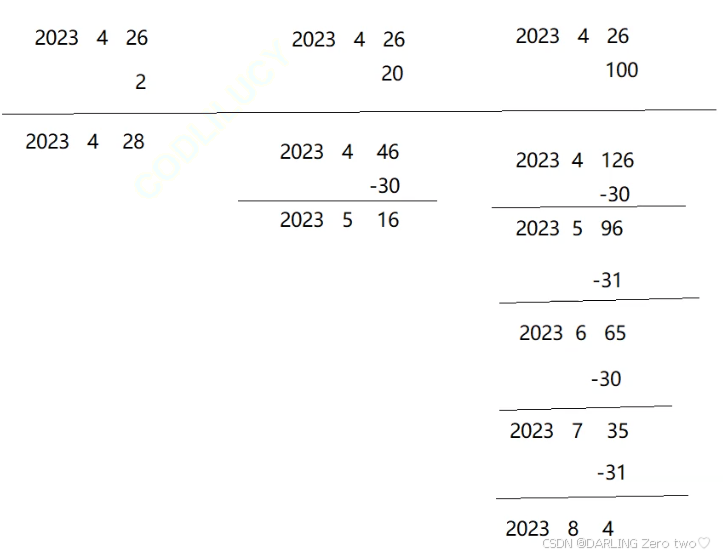
首先我们要明白日期+天数如何计算,那么经过举例演算可以发现,用进位的方式实现日期+天数,简单来说就是天满了往月进,月满了往年进,依赖于GetMonthDay函数处理每个月的天数,不断减掉天数直到合法为止
Date& Date::operator+=(int day)
{
if (day < 0)
{
*this -= -day;
}
_day += day;
while (_day > GetMonthDay(_year, _month))
{
_day -= GetMonthDay(_year, _month);
++_month;
if (_month == 13)
{
++_year;
_month = 1;
}
}
return *this;
}
- 1
- 2
- 3
- 4
- 5
- 6
- 7
- 8
- 9
- 10
- 11
- 12
- 13
- 14
- 15
- 16
- 17
- 18
- 19
因为我们是在原本的日期上操作,所以是+=且引用返回,而不是+,注意加上负数等同于减去正数,也可以用abs取绝对值
Date& Date::operator+=(int day)
{
*this = *this + day;
return *this;
}
- 1
- 2
- 3
- 4
- 5
+=还可以利用下面实现的日期+天数的运算来写
2.2.2 日期+天数
Date Date::operator+(int day)
{
Date tmp(*this);
tmp._day += day;
while (tmp._day > GetMonthDay(tmp._year, tmp._month))
{
tmp._day -= GetMonthDay(tmp._year, tmp._month);
++tmp._month;
if (tmp._month == 13)
{
++_year;
tmp._month = 1;
}
}
return tmp;
}
- 1
- 2
- 3
- 4
- 5
- 6
- 7
- 8
- 9
- 10
- 11
- 12
- 13
- 14
- 15
- 16
- 17
那么真正的日期+天数,应该是不会修改原来的日期的,而是以另一个变量返回,所以这里就可以利用拷贝构造,将一个新的日期返回,注意不能引用返回,因为tmp是局部变量,出了作用域就被销毁了
Date Date::operator+(int day)
{
Date tmp(*this);
tmp += day;
return tmp;
}
- 1
- 2
- 3
- 4
- 5
- 6
- 7
同理+也可以利用日期+=天数来运算,但是这两种简洁的写法不可能同时存在,因为至少要有一种是完整实现了的,那么就可以对两种组合进行比对
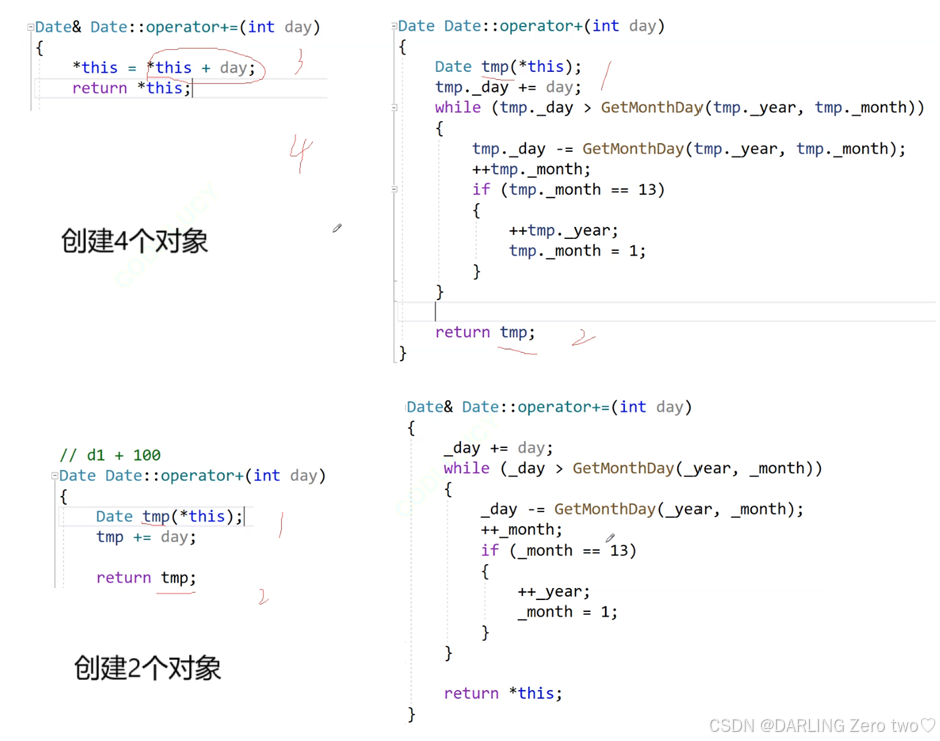
考虑到变量的拷贝以及创建,明显是创建完整的+=运算,然后据此写+运算更优,因为这个组合创建的对象更少,减少对拷贝构造的调用
2.2.3 日期−=天数

举一反三,既然日期+天数是进位,那么日期-天数就是借位,每当被减成负数的时候,要注意是向上个月借天数,不是本月的天数
Date& Date::operator-=(int day)
{
if (day < 0)
{
*this += -day;
}
_day -= day;
while (_day <= 0)
{
--_month;
if (_month == 0)
{
_month = 12;
--_year;
}
_day += GetMonthDay(_year, _month);
}
return *this;
}
- 1
- 2
- 3
- 4
- 5
- 6
- 7
- 8
- 9
- 10
- 11
- 12
- 13
- 14
- 15
- 16
- 17
- 18
- 19
和+=的写法其实大差不差,注意减去负数就是加上正数
2.2.4 日期−天数
Date Date::operator-(int day)
{
Date tmp(*this);
*this -= day;
return tmp;
}
- 1
- 2
- 3
- 4
- 5
- 6
利用-=运算减少不必要的算法,记得保存原先的日期
2.3 日期的自增自减
2.3.1 前置++
Date& Date::operator++()
{
*this += 1;
return *this;
}
- 1
- 2
- 3
- 4
- 5
在+=运算的前提下,日期也是能实现自增的,所以不用担心自增后会不会越过当月的天数,在+=已经处理好了
2.3.2 后置++
Date Date::operator++(int)
{
Date tmp = *this;
*this += 1;
return tmp;
}
- 1
- 2
- 3
- 4
- 5
- 6
后置++需要提前保存值,因为是先使用再++
?值得注意的是:
前置++和后置++虽然是运算符重载,但是形式上也构成函数重载后置++增加这个int参数不是为了接受具体的值,仅仅是占位,跟前置++构成重载- int这个位置
传任何值都可以,实际调用的时候前置++和后置++可能分别为d1.operator++()和d1.operator++(0),括号内的值是随机的
2.3.3 前置−−
Date& Date::operator--()
{
*this -= 1;
return *this;
}
- 1
- 2
- 3
- 4
- 5
−−的操作和++几乎是一样的,这里就不过多赘述了
2.3.4 后置−−
Date Date::operator--(int)
{
Date tmp = *this;
*this -= 1;
return tmp;
}
- 1
- 2
- 3
- 4
- 5
- 6
2.4 日期-日期
通常日期的计算我们一般是用来计算两个日期之前相差多少天,因此我们的运算符重载是否有意义决定了是否要创建这个重载,所以只考虑日期-日期,日期+日期是没有意义的
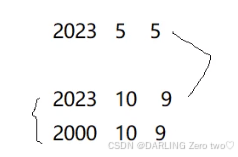
根据前面的算法,我们也能很容易总结出计算方法,把年份大的的日期的月份天数,假设成和一样的年份小的一样,然后两者作天数差的计算即可
其实还有更简单的思路,就是让年份小的日期一天一天去++
int Date::operator-(const Date& d)
{
Date max = *this;
Date min = d;
int flag = 1;
if (*this < d)
{
max = d;
min = *this;
flag = -1;
}
int n = 0;
while (min != max)
{
++min;
++n;
}
return n * flag;
}
- 1
- 2
- 3
- 4
- 5
- 6
- 7
- 8
- 9
- 10
- 11
- 12
- 13
- 14
- 15
- 16
- 17
- 18
- 19
这里最妙的是这个flag,能够刚好体现出计算的正负,虽然这种方式没有上面那种来的快,但是这种程度的差距对于计算机来说其实是可以忽略不计的
2.5 日期的输入输出
基本数据类型基于cout和cin的使用能够很方便的进行输入输出的操作,那么日期依托于运算符重载也能达到此类效果,cout和cin分别属于iostram库里的ostream和istream
2.5.1 <<运算符重载
根据前面的经验,我们依旧把<<运算符重载放在成员函数里
void Date::operator<<(ostream& out)
{
out << d._year << "年" << d._month << "月" << d._day;
}
- 1
- 2
- 3
- 4
可是当我们输出的时候就报错了,这是因为正常情况下cout<d1.operator<Date对象默认占用第一个参数,也就是做了左操作数,所以正确的写法应该是d1<不符合我们的使用习惯
ostream& operator<<(ostream& out, const Date& d)
{
out << d._year << "年" << d._month << "月" << d._day;
return out;
}
- 1
- 2
- 3
- 4
- 5
既然不能写成成员函数,那就在类外写成非成员函数,就可以带入两个参数,cout<operator<<(cout,d1),符合书写情况
?值得注意的是:
- cout
从左往右连续输出,所以要返回ostream类型才能连续输出 - 类外访问私有变量使用
友元函数就能解决 ostream& out前不能加const,因为流插入就是不断改变cout的过程
2.5.2 >>运算符重载
istream& operator>>(istream& in, const Date& d)
{
in >> d._year >> d._month >> d._day;
return in;
}
- 1
- 2
- 3
- 4
- 5
同理,流输入也是同样的格式
3.代码展示
3.1 Date.h
#include - 1
- 2
- 3
- 4
- 5
- 6
- 7
- 8
- 9
- 10
- 11
- 12
- 13
- 14
- 15
- 16
- 17
- 18
- 19
- 20
- 21
- 22
- 23
- 24
- 25
- 26
- 27
- 28
- 29
- 30
- 31
- 32
- 33
- 34
- 35
- 36
- 37
- 38
- 39
- 40
- 41
- 42
- 43
- 44
- 45
- 46
- 47
- 48
- 49
- 50
- 51
- 52
- 53
- 54
- 55
- 56
- 57
- 58
- 59
- 60
- 61
- 62
- 63
- 64
3.2 Date.c
//1.<运算符重载
bool Date::operator < (const Date& x)
{
if (_year < x._year)
{
return true;
}
else if (_year == x._year && _month < x._month)
{
return true;
}
else if (_year == x._year && _month == x._month && _year < x._year)
{
return true;
}
return false;
}
//2.>的运算符重载
bool Date::operator > (const Date& x)
{
if (_year > x._year)
{
return true;
}
else if (_year == x._year && _month > x._month)
{
return true;
}
else if (_year == x._year && _month == x._month && _year > x._year)
{
return true;
}
return false;
}
bool Date::operator > (const Date& x)
{
return !(*this <= x);
}
//3.=的运算符重载
///*void operator=(const Date& d)
//{
// _year = d._year;
// _month = d._month;
// _day = d._month;
//}*/
//Date& Date::operator=(const Date& d)
//{
// if (this != &d)
// {
// _year = d._year;
// _month = d._month;
// _day = d._day;
// }
// return *this;
//}
//4.==的运算符重载
bool Date::operator==(const Date& x)
{
return _year == x._year
&& _month == x._month
&& _day == x._day;
}
//5.<=的运算符重载
bool Date::operator<=(const Date& x)
{
return *this < x || *this == x;
}
//6.>=的运算符重载
bool Date::operator>=(const Date& x)
{
return !(*this < x);
}
//7.!=的运算符重载
bool Date::operator!=(const Date& x)
{
return !(*this == x);
}
//8.+=的运算符重载
Date& Date::operator+=(int day)
{
if (day < 0)
{
*this -= -day;
}
//*this = *this + day;
//return *this;
_day += day;
while (_day > GetMonthDay(_year, _month))
{
_day -= GetMonthDay(_year, _month);
++_month;
if (_month == 13)
{
++_year;
_month = 1;
}
}
return *this;
}
//9.+的运算符重载
Date Date::operator+(int day)
{
Date tmp(*this);
tmp += day;
return tmp;
/*tmp._day += day;
while (tmp._day > GetMonthDay(tmp._year, tmp._month))
{
tmp._day -= GetMonthDay(tmp._year, tmp._month);
++tmp._month;
if (tmp._month == 13)
{
++_year;
tmp._month = 1;
}
}
return tmp;*/
}
//10.前置++
Date& Date::operator++()
{
*this += 1;
return *this;
}
//11.后置++
Date Date::operator++(int)
{
Date tmp = *this;
*this += 1;
return tmp;
}
//12.-=的运算符重载
Date& Date::operator-=(int day)
{
if (day < 0)
{
*this += -day;
}
_day -= day;
while (_day <= 0)
{
--_month;
if (_month == 0)
{
_month = 12;
--_year;
}
_day += GetMonthDay(_year, _month);
}
return *this;
}
//13.-的运算符重载
Date Date::operator-(int day)
{
Date tmp(*this);
*this -= day;
return tmp;
}
//14.前置--
Date& Date::operator--()
{
*this -= 1;
return *this;
}
//15.后置--
Date Date::operator--(int)
{
Date tmp = *this;
*this -= 1;
return tmp;
}
//16.日期-日期
int Date::operator-(const Date& d)
{
Date max = *this;
Date min = d;
int flag = 1;
if (*this < d)
{
max = d;
min = *this;
flag = -1;
}
int n = 0;
while (min != max)
{
++min;
++n;
}
return n * flag;
}
//17.输出日期
ostream& operator<<(ostream& out, const Date& d)
{
out << d._year << "年" << d._month << "月" << d._day;
return out;
}
//18.输入日期
istream& operator>>(istream& in, const Date& d)
{
in >> d._year >> d._month >> d._day;
return in;
}
- 1
- 2
- 3
- 4
- 5
- 6
- 7
- 8
- 9
- 10
- 11
- 12
- 13
- 14
- 15
- 16
- 17
- 18
- 19
- 20
- 21
- 22
- 23
- 24
- 25
- 26
- 27
- 28
- 29
- 30
- 31
- 32
- 33
- 34
- 35
- 36
- 37
- 38
- 39
- 40
- 41
- 42
- 43
- 44
- 45
- 46
- 47
- 48
- 49
- 50
- 51
- 52
- 53
- 54
- 55
- 56
- 57
- 58
- 59
- 60
- 61
- 62
- 63
- 64
- 65
- 66
- 67
- 68
- 69
- 70
- 71
- 72
- 73
- 74
- 75
- 76
- 77
- 78
- 79
- 80
- 81
- 82
- 83
- 84
- 85
- 86
- 87
- 88
- 89
- 90
- 91
- 92
- 93
- 94
- 95
- 96
- 97
- 98
- 99
- 100
- 101
- 102
- 103
- 104
- 105
- 106
- 107
- 108
- 109
- 110
- 111
- 112
- 113
- 114
- 115
- 116
- 117
- 118
- 119
- 120
- 121
- 122
- 123
- 124
- 125
- 126
- 127
- 128
- 129
- 130
- 131
- 132
- 133
- 134
- 135
- 136
- 137
- 138
- 139
- 140
- 141
- 142
- 143
- 144
- 145
- 146
- 147
- 148
- 149
- 150
- 151
- 152
- 153
- 154
- 155
- 156
- 157
- 158
- 159
- 160
- 161
- 162
- 163
- 164
- 165
- 166
- 167
- 168
- 169
- 170
- 171
- 172
- 173
- 174
- 175
- 176
- 177
- 178
- 179
- 180
- 181
- 182
- 183
- 184
- 185
- 186
- 187
- 188
- 189
- 190
- 191
- 192
- 193
- 194
- 195
- 196
- 197
- 198
- 199
- 200
- 201
- 202
- 203
- 204
- 205
- 206
- 207
- 208
- 209
- 210
- 211
- 212
- 213
- 214
- 215
- 216
- 217
- 218
- 219
- 220
- 221
- 222
- 223
- 224
- 225
希望读者们多多三连支持
小编会继续更新
你们的鼓励就是我前进的动力!

 微信名片
微信名片


评论记录:
回复评论: